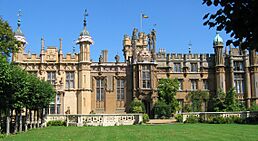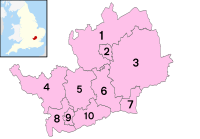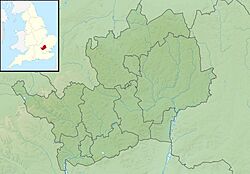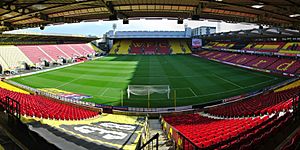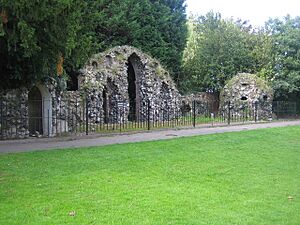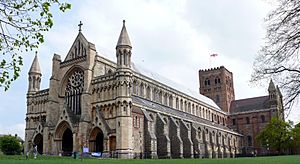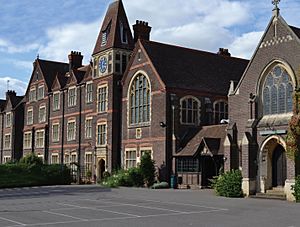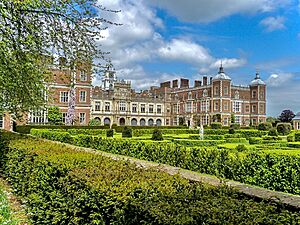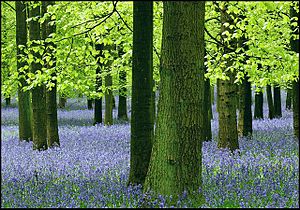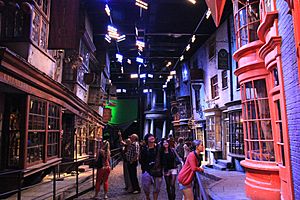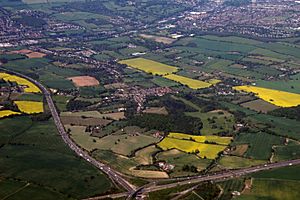Hertfordshire facts for kids
Quick facts for kids
Hertfordshire
|
|||||||||||||||||||||||||||||||||||||||||||||||||||||
|---|---|---|---|---|---|---|---|---|---|---|---|---|---|---|---|---|---|---|---|---|---|---|---|---|---|---|---|---|---|---|---|---|---|---|---|---|---|---|---|---|---|---|---|---|---|---|---|---|---|---|---|---|---|
|
|
|||||||||||||||||||||||||||||||||||||||||||||||||||||
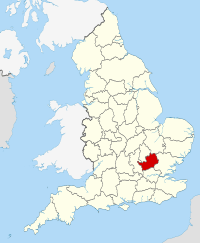 |
|||||||||||||||||||||||||||||||||||||||||||||||||||||
| Sovereign state | United Kingdom | ||||||||||||||||||||||||||||||||||||||||||||||||||||
| Constituent country | England | ||||||||||||||||||||||||||||||||||||||||||||||||||||
| Region | East | ||||||||||||||||||||||||||||||||||||||||||||||||||||
| Established | Likely 10th century | ||||||||||||||||||||||||||||||||||||||||||||||||||||
| Time zone | UTC±00:00 (Greenwich Mean Time) | ||||||||||||||||||||||||||||||||||||||||||||||||||||
| • Summer (DST) | UTC+01:00 (British Summer Time) | ||||||||||||||||||||||||||||||||||||||||||||||||||||
| Members of Parliament | List of MPs | ||||||||||||||||||||||||||||||||||||||||||||||||||||
| Police | Hertfordshire Constabulary | ||||||||||||||||||||||||||||||||||||||||||||||||||||
| Largest town | Watford | ||||||||||||||||||||||||||||||||||||||||||||||||||||
|
|||||||||||||||||||||||||||||||||||||||||||||||||||||
Hertfordshire (often called Herts for short) is a county in the East of England. It's one of the "home counties," which means it's close to London. Hertfordshire shares its borders with Bedfordshire to the north-west, Cambridgeshire to the north-east, Essex to the east, Greater London to the south, and Buckinghamshire to the west.
The biggest town in Hertfordshire is Watford, and the county town (where the main local government offices are) is Hertford. The county covers about 1,643 square kilometers (634 square miles). In 2021, about 1.2 million people lived here. After Watford, other large towns include Hemel Hempstead, Stevenage, and the city of St Albans.
Hertfordshire has higher land in the north and west, especially in the Chilterns area near Tring. The county has many farms, and a lot of its open land is part of the Metropolitan Green Belt. This is a special area that helps stop cities from growing too much.
Hertfordshire is known for its "garden cities" and "new towns." Letchworth was the world's first garden city, designed to combine city life with nature. Stevenage was one of the first towns to be planned and built after World War II. Today, most jobs in Hertfordshire are in the services sector, like shops, offices, and healthcare.
Contents
Exploring Hertfordshire's Past
Hertfordshire has a long and interesting history, with many old buildings and landmarks. You can find everything from ancient Roman sites to famous film studios. Many medieval and Tudor buildings are still standing, especially in St Albans. This city also has parts of the Roman town of Verulamium.
How Hertfordshire Got Its Name
The name "Hertfordshire" comes from the town of Hertford. In 913, a fortress was built there by Edward the Elder. "Hertford" comes from an old Anglo-Saxon phrase, heort ford, which means "deer crossing." The name Hertfordshire first appeared in a history book called the Anglo-Saxon Chronicle in 1011. That's why you often see deer on the county's emblems!
Many towns in Hertfordshire have names that date back to the Anglo-Saxon period. Words like "ford," "ton," "den," and "stead" are common in these old names. For example, Hertford, Royston, Harpenden, and Wheathampstead.
Early Human Life in Hertfordshire
People have lived in Hertfordshire for a very long time, since the Mesolithic period (Middle Stone Age). Farming started here during the Neolithic period (New Stone Age), and permanent homes appeared in the Bronze Age. Later, different tribes settled in the area during the Iron Age.
Roman Times and Saint Alban
When the Romans conquered Britain in AD 43, the local Catuvellauni tribe quickly became part of Roman life. This led to the growth of new towns, like Verulamium (now St Albans). Around 293 AD, the first recorded Christian martyr in Britain, Saint Alban, is believed to have died here. He was a Roman soldier who bravely took the place of a Christian priest. He was beheaded on Holywell Hill.
Saint Alban's story is important to Hertfordshire. His special cross (a yellow cross on a blue background) is shown on the county flag and coat of arms. The yellow background behind the stag (or "Hart") represents the county. Saint Alban is the patron saint of Hertfordshire.
Anglo-Saxon and Viking Times
After the Roman soldiers left in the early 5th century, the area was invaded by the Anglo-Saxons. By the 6th century, most of what is now Hertfordshire was part of the East Saxon kingdom. This kingdom didn't last long, and by the 9th century, Hertfordshire was controlled by the Mercians. It finally became an English shire (county) in the 10th century.
During the Viking invasions, Hertfordshire was often on the front lines. King Edward the Elder built a fort in Hertford to stop Viking attacks. His father, King Alfred the Great, even set the River Lea as a border between his kingdom and the Viking-controlled lands. Even though there were Viking raids, many Anglo-Saxon traditions and names stayed in the area.
Norman Conquest and Later Years
In 1066, after the Battle of Hastings, William the Conqueror received the surrender of English lords and clergy at Berkhamsted. This led to him becoming the new King of England. The Normans built new castles in Hertfordshire, like at Bishop's Stortford.
Later, during the Wars of the Roses, St Albans was the site of two big battles. In Tudor times, Hatfield House was a favorite place for Queen Elizabeth I. King James I used the area for hunting and helped build the New River, which brought drinking water to London.
As London grew, Hertfordshire became a popular place for rich and important people to live. This helped the local economy. The biggest boost came during the Industrial Revolution, when the population grew a lot. In 1903, Letchworth became the world's first "garden city." Later, Stevenage was developed as a "New Town" after World War II.
Hertfordshire in Modern Times
Hertfordshire has played a part in more recent history too. The first German airship (zeppelin) shot down over Britain during World War I happened in Cuffley.
From the 1920s to the 1980s, Borehamwood was home to major British film studios, including MGM-British Studios. Many famous movies were made here, like the first three Star Wars films! American director Stanley Kubrick also lived and filmed in the area. Today, TV shows like EastEnders are filmed at Elstree.
Warner Bros. Studios, Leavesden is another important film location in Hertfordshire. The Harry Potter movies were filmed here, and you can now visit the popular Making of Harry Potter studio tour.
Geography and Landscape
Hertfordshire is in the south-eastern part of England, just north of London. It's part of the East of England region. To the east is Essex, to the west is Buckinghamshire, and to the north are Bedfordshire and Cambridgeshire. Many people who live in Hertfordshire travel to Central London for work.
The county's borders were mostly set in 1844. In 1965, some areas near London, like Potters Bar, became part of Hertfordshire. The highest point in the county is about 244 meters (800 feet) above sea level, near Tring.
Hertfordshire doesn't have huge cities like Luton or Milton Keynes. However, its total population is larger than those of Bedfordshire and Buckinghamshire. The River Lea flows through towns like Harpenden, Welwyn Garden City, and Hertford. The western part of the county is hillier, with the Chiltern Hills near Tring and Berkhamsted. This area is known for its beautiful natural scenery.
Many of Hertfordshire's main towns are in the central, northern, and southern areas. These include Watford, Hemel Hempstead, St Albans, Stevenage, and Welwyn Garden City. Some are historic, like St Albans with its Roman ruins and Norman cathedral. Others, like Stevenage, are "new towns" planned after World War II.
The eastern parts of Hertfordshire are mostly rural, with farms, villages, and smaller towns. These include Royston, Buntingford, and Bishop's Stortford. The landscape here is less hilly but has rivers like the River Stort.
Hertfordshire's Natural Environment
Much of Hertfordshire has beautiful and varied countryside. You can find beech woods in the Chiltern Hills and ancient hornbeam forests. There are also wide open chalklands near Royston and Tring.
A lot of the county's land is used for farming. Some areas also have quarries for sand and gravel. In the past, clay was used for making bricks. The chalk rock under much of the county holds water, which feeds streams and provides water for many homes.
The New River, built in 1613, still supplies fresh water to London from Ware. Hertfordshire's rivers, though small, helped early industries like paper making.
Hertfordshire is home to many different plants and animals. The Pasqueflower, a purple star-shaped flower, is considered one of the county's special flowers.
Major Towns and Cities
Hertfordshire's Economy
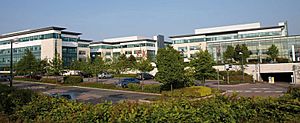
Hertfordshire is home to many large companies and employers. Here are some examples:
- In Stevenage, companies like MBDA (which develops missiles) and Airbus (which makes satellites) have major sites.
- Hatfield was once where de Havilland developed the first commercial jet plane, the Comet. Now, it's a business park and a campus for the University of Hertfordshire. Big companies like EE, Computacenter, and Ocado (an online grocery store) are based here.
- Welwyn Garden City is home to Tesco's UK headquarters and a Cereal Partners factory. Pharmaceutical companies like Roche UK and GlaxoSmithKline also have sites in Welwyn Garden City and Ware.
- Hemel Hempstead has large offices for Dixons Carphone.
- The National Pharmacy Association, which supports UK pharmacies, is based in St Albans.
- Kings Langley has a factory for Pure, which makes digital radios.
- Watford hosts national companies like J D Wetherspoon (a pub chain) and Camelot Group (who run the National Lottery). Many international companies like Hilton Worldwide and TK Maxx also have their UK bases here. Warner Bros. runs its main UK film studios in Leavesden, Watford.
- Rickmansworth is home to Skanska, a large construction company.
Media and Communication
Television in Hertfordshire
Local news and TV shows for Hertfordshire are mainly provided by BBC London and ITV London. However, if you live in the northern parts of the county, you might get news from BBC East and ITV Anglia, which are based in Norwich.
Radio Stations
You can listen to several local radio stations in Hertfordshire. These include BBC Three Counties Radio, Heart Hertfordshire, and Greatest Hits Radio Bucks, Beds and Herts. There are also smaller community radio stations like Mix 92.6 (formerly Radio Verulam St. Albans) and Community Radio Dacorum.
Sports and Activities
Hertfordshire offers many sports, from water activities to football and rugby.
Watersports Fun
Waltham Cross, in Broxbourne, is home to the Lee Valley White Water Centre. This amazing place was built for the 2012 Summer Olympics. It has two white water courses: a 300-meter "Olympic" run and a 160-meter "legacy" run.
During the Olympics, it hosted the canoe and kayak slalom events. Since then, Lee Valley has hosted the ICF Canoe Slalom World Championships twice, in 2015 and 2023. In 2023, Britain won the most gold medals there!
Football in the County
Hertfordshire has several professional football teams. As of the 2021–22 season, these include Watford F.C., Stevenage F.C., Arsenal W.F.C., and Boreham Wood F.C..
- Watford F.C. plays its home games at Vicarage Road. They joined the Football League in 1920. They even finished second in the top English league in 1982. Watford was promoted to the Premier League in 2021 but was relegated back to the Championship in 2022.
- Stevenage F.C. was formed in 1976 and plays at Broadhall Way. They were the first club to win a game at the new Wembley Stadium in 2007. They currently play in EFL League Two.
- Arsenal F.C. (the men's team) has its training ground in Hertfordshire, even though their main stadium is in London.
- Arsenal W.F.C. (the women's team) plays at Meadow Park in Borehamwood. They were formed in 1987 and play in the FA Women's Super League.
Hertfordshire also has many semi-professional and amateur football clubs.
Rugby in Hertfordshire
Rugby League
The Hemel Stags are a rugby league team based in Hemel Hempstead. They have played at Pennine Way Stadium since 1981. They now compete in the Conference League South.
Rugby Union
The Hertfordshire Rugby Football Union manages rugby union in the county. Tring Rugby plays its matches at Cow Lane, Tring. Their first team plays in the Regional 1 South East league.
Gaelic Games
Gaelic Football is played in Hertfordshire, with clubs from different areas competing in the Hertfordshire League. Hurling is also played by a combined team called St Declan's CLG.
Famous Landmarks and Attractions
Here are some popular places to visit in Hertfordshire:
- Aldenham Country Park: A great place for outdoor fun.
- Ashridge: A large estate with beautiful woods and walking paths, owned by the National Trust.
- Bridgewater Monument: A tall tower built in 1832. You can climb to the top for amazing views!
- Berkhamsted Castle: The ruins of an old castle.
- Cedars Park, Broxbourne: A historic park that was once home to Theobalds Palace, a favorite residence of King James I.
- de Havilland Aircraft Heritage Centre: A museum where you can see old airplanes.
- Frogmore Paper Mill, Apsley: A historic paper mill.
- Hatfield:
- Hatfield House: A beautiful old Jacobean house with lovely gardens.
- Mill Green Watermill: An old watermill in Hatfield.
- University of Hertfordshire: A large university in Hatfield.
- Henry Moore Foundation, Much Hadham: A sculpture park featuring the works of artist Henry Moore.
- Knebworth House: A grand country house with a large park, famous for hosting rock and pop festivals.
- Leavesden Film Studios: Home to the amazing Making of Harry Potter studio tour.
- Letchworth Garden City: The world's first "Garden City," known for its unique town planning.
- Magic Roundabout (Hemel Hempstead): A very complex road junction!
- Royston Cave: A mysterious cave in Royston town center.
- Rye House Gatehouse in Hoddesdon: Part of the site of the Rye House Plot, a plan to assassinate King Charles II.
- St Albans:
- Beech Bottom Dyke: A very large Iron Age ditch.
- St Albans Cathedral: A stunning Norman cathedral.
- Verulamium: The remains of a Roman town, with a museum and amphitheater.
- Scott's Grotto, Ware: A hidden grotto.
- Shaw's Corner, Ayot St Lawrence: The former home of famous writer George Bernard Shaw.
- Stevenage: The first "New Town" in the UK.
- Six Hills: Ancient Roman burial mounds.
- Therfield Heath: A nature reserve in the north of the county.
- Welwyn Roman Baths: The remains of Roman baths.
- Welwyn Viaduct: An impressive railway bridge north of Welwyn Garden City.
- Walter Rothschild Zoological Museum, Tring: A museum with a huge collection of animals.
- Watford Museum: A museum about local history and art.
Popular Walking Paths
Hertfordshire has many great footpaths for walking and exploring the countryside:
- The Ridgeway
- Icknield Way
- Grand Union Canal Walk
- Harcamlow Way
- Hertfordshire Way
- Hertfordshire Chain Walk
Getting Around Hertfordshire
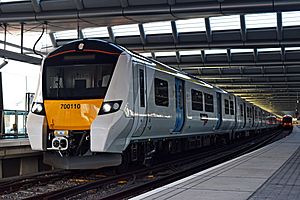
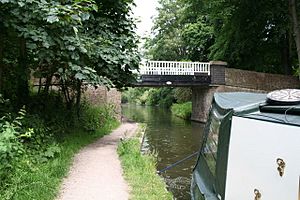
Hertfordshire is well-connected by roads and railways, making it easy to travel around. Many towns are part of the London commuter belt, meaning people travel to London for work.
Major Roads
Important roads that pass through Hertfordshire include the A1, A1(M), A41, A414, M1, M11, and the M25 (London's orbital motorway).
Train Services
Four main railway lines cross the county:
- The West Coast Main Line: Connects London Euston to the Midlands, North West England, and Scotland.
- The East Coast Main Line: Connects London King's Cross to Northern England and Scotland.
- The Midland Main Line: Part of the Thameslink route, connecting Bedford to Brighton through Central London.
- The West Anglia Main Line: Connects London Liverpool Street to the east of the county.
Other local train routes also run through Hertfordshire, like the London to Aylesbury Line and the Abbey Line (from Watford to St Albans Abbey). Five stations on the London Underground Metropolitan line are also in Hertfordshire.
Airports and Canals
Stansted Airport and Luton Airport are both very close to Hertfordshire's borders. For light aircraft, there's a commercial airfield at Elstree.
The Grand Union Canal also passes through several towns in Hertfordshire, including Rickmansworth, Watford, Hemel Hempstead, Berkhamsted, and Tring.
Education and Learning
Hertfordshire has 26 independent (private) schools and 73 state secondary schools. All state secondary schools are comprehensive, meaning they accept students of all abilities. Some schools in the south and southwest of the county are "partially selective," meaning they might have some places based on academic ability.
All state schools in Hertfordshire have sixth forms, which are for students aged 16-18. There are no separate sixth form colleges. The county also has several colleges for further education, like Hertford Regional College and North Hertfordshire College.
The University of Hertfordshire is a modern university mainly based in Hatfield. It has over 23,000 students studying a wide range of subjects.
Hertfordshire in Books
Hertfordshire has been featured in several famous books:
- In Oscar Wilde's play The Importance of Being Earnest, one of the main characters, Jack Worthing, has a country house in Hertfordshire.
- Jane Austen's famous novel Pride and Prejudice is mostly set in Hertfordshire.
- Mr. Jarndyce's Bleak House in Charles Dickens's novel Bleak House is located near St Albans.
- The house in E. M. Forster's novel Howards End was based on Rooks Nest House near Stevenage.
- George Orwell based his famous book Animal Farm on Wallington, Hertfordshire, where he lived for several years.
See also
 In Spanish: Hertfordshire para niños
In Spanish: Hertfordshire para niños


